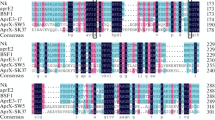Abstract
Bacillus strains have been widely used for the production of fibrinolytic enzymes having role in the treatment of cardiovascular disorders. Purification and overproduction of such enzymes has increased their usage in medical fields including metalloproteinases with the ability to degrade extracellular matrix (ECM). Camelysin, a neutral metalloproteinase has been isolated from different species of bacteria like Bacillus cereus, Bacillus anthracis, and Bacillus thuringiensis with fibrinolytic, collagenolytic and actin degradation activity. This project successfully demonstrated the presence of 734-bp coding DNA sequence (CDS) encoding a 20.72331 kDa camelysin gene in local strain of Bacillus thuringiensis containing a signal peptide with cleavage site between residues 19 and 20. The sequence was submitted to GenBank (KT023597) and the sequence showed high homology with the camelysin protein of closely related Bacillus species. The alignment of related proteins through ClustalW displayed difference of four amino acids (“Q” replaced by “P” at position 169 and at position 182–184, “NQE” replaced by “HLK”) in the isolated protein. Comparison including structural and functional analysis of camelysin sequences isolated from different Bacillus species was carried out using different bioinformatics tools and software. The information would help in better understanding the properties of camelysin protein and its role in pathogenicity and clinical treatments.


Similar content being viewed by others
References
Ageno W, Gallus AS, Wittkowsky A, Crowther M, Hylek EM, Palareti G (2012) Oral anticoagulant therapy. Antithrombotic therapy and prevention of thrombosis, 9th ed: American College of Chest Physicians Evidence-based clinical practice guidelines. Chest 141(2):e44S–e88S
Bauer MA, Derbyshire MK, Gonzales NR, Lu S, Chitsaz F, Geer LY, Geer RC, He J, Gwadz M, Hurwitz DI, Lanczycki CJ (2014) CDD: NCBI’s conserved domain database. Nucleic Acids Res 43:D222–D226
Chakrabarti I (2010) A minireview: matrix metalloproteases-an invasive arm of nematode parasites. In: 22nd National Congress of Parasitology. Department of zoology, University of Kalyani, Kalyani, pp 98–101
Dubey R, Kumar J, Agrawala D, Char T, Pusp P (2011) Isolation, production, purification, assay and characterization of fibrinolytic enzymes (Nattokinase, Streptokinase and Urokinase) from bacterial sources. Afr J Biotech 10(8):1408–1420
Fricke B, Buchmann T, Friebe S (1995) Unusual chromatographic behaviour and one-step purification of a novel membrane proteinase from Bacillus cereus. J Chromatogr A 715(2):247–258
Fricke B, DroMler K, Willhardt I, Schierhorn A, Menge S, Rücknagel P (2001) The cell envelope-bound metalloprotease (camelysin) from Bacillus cereus is a possible pathogenic factor. Biochem Biophys Acta 1537(2):132–146
Ganguly K, Sharma AV, Reiter RJ, Swarnakar S (2010) Melatonin promotes angiogenesis during protection and healing of indomethacin-induced gastric ulcer: role of matrix metalloproteinase-2. J Pineal Res 49(2):130–140
Grass G, Schierhorn A, Sorkau E, Muller H, Rucknagel P, Nies DH, Fricke B (2004) Camelysin is a novel surface metalloproteinase from Bacillus cereus. J Infect Immun 72(1):219–228
Hadler-Olsen E, Winberg JO, Uhlin-Hansen L (2013) Matrix metalloproteinases in cancer: their value as diagnostic and prognostic markers and therapeutic targets. Tumor Biol 34(4):2041–2051
Kotb E (2013) Activity assessment of microbial fibrinolytic enzymes. Appl Microbiol Biotechnol 97(15):6647–6665
Mushtaq Z, Jamil A (2012) Isolation of a fibrinolytic enzyme BKII gene from local isolate of Bacillus. J Chem Biochem Sci 2:94–100
Myers AR (2005) Cloning, expression, and sequence analysis of camelysin, a zinc metalloprotease from Bacillus anthracis and B. cereus. Graduate Theses and Dissertations. University of South Florida Scholar Commons, Tampa
Nisnevitch M, Sigawi S, Cahan R, Nitzan Y (2010) Isolation, characterization and biological role of camelysin from Bacillus thuringiensis subsp. Israelensis. Curr Microbiol 61(3):176–183
Okafor ON, Gorog DA (2015) Endogenous fibrinolysis an important mediator of thrombus formation and cardiovascular risk. J Am Coll Cardiol 65(16):1683–1699
Petersen B, Petersen TN, Andersen P, Nielsen M, Lundegaard C (2009) A generic method for assignment of reliability scores applied to solvent accessibility predictions. BMC Struct Biol 9(1):51
Wilson K (1987) Preparation of genomic DNA from bacteria. In: Ausubel FM, Brent R, Kingston RE, Moore DD, Seidman JG, Smith JA, Struhl K (eds) Current protocols in molecular biology. John Wiley & Sons, New York, pp 2.4.1–2.4.5
Author information
Authors and Affiliations
Corresponding author
Rights and permissions
About this article
Cite this article
Irshad, F., Mushtaq, Z. & Akhtar, S. Sequence Analysis and Comparative Bioinformatics Study of Camelysin Gene (calY) Isolated from Bacillus thuringiensis . Biochem Genet 56, 103–115 (2018). https://doi.org/10.1007/s10528-017-9833-6
Received:
Accepted:
Published:
Issue Date:
DOI: https://doi.org/10.1007/s10528-017-9833-6




